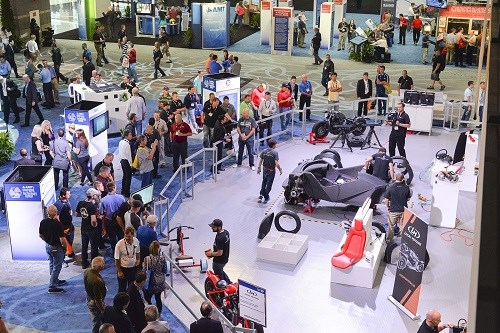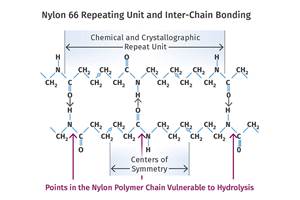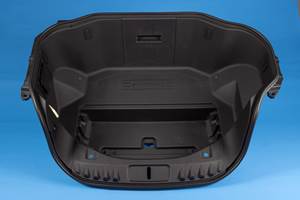New Details On Big Area Additive Manufacturing (BAAM) Project
The BAAM machine from Cincinnati Inc. continues to evolve with more pros involved so that by next year, the company will be taking orders for beta level and production machines.

As I discussed in an earlier blog this week, the launch of Cincinnati Inc.’s prototype Big Area Additive Manufacturing Machine (BAAM) made a big splash at the recent IMTS show in Chicago, and further development of what is already an impressive machine is underway.
A couple more interesting tidbits about BAAM were passed onto me by my colleague Jim Callari. One is that Dri-Air Industries furnished the dryers for the carbon fiber reinforced ABS that was used for the Strati car project that was produced during IMTS. The other is that a well-known authority in plastics processing and machinery designed the screw for the project. The original screw used was generating 10 lb/hr but the new design from this pro boosted BAAM’s output to 35-40 lb/hr, as noted in the earlier blog. This pro has also signed up to design and build new extruders for this evolving project.
As reported previously, BAAM resulted from the formation of the company’s partnership earlier this year with Oak Ridge National Laboratory (ORNL) to develop a large-scale additive manufacturing system. The partners aim: to introduce significant new capabilities to the U.S. machine tool sector which supplies manufacturing technology to automotive, aerospace, appliance, and robotic industries.
The prototype machine uses the chassis and drives of Cincinnati Inc.’s gantry-style laser cutting systems at the base, and incorporates a high-speed cutting tool, pellet feed mechanism, and control software. Cincinnati Inc.’s market development manager Rick Neff explained to me how the company participated with Local Motors, Sabic and ORNL to take on the challenge to 3D print a car during the IMTS trade show.
Printing started on Sunday morning at 7 am, and by 6 am Tuesday, they had printed the main structure of the car including the frame, seats, cockpit, hood and tail in one 1000-lb piece. The rough part was then taken to a Thermwood Router where the surfaces that needed to be accurately machined smooth were routed smooth.
On Wednesday through Saturday morning, the Local Motors crew attached a drive train, suspension, steering wheel, instruments, brakes and some trim to complete the car. The car, named Strati (Italian for layers), uses a drive train from Renault that is employed in the European Twizy City Car. “Right on schedule at 9 am Saturday, we fired up the Strati and drove it out of the show…the reaction from the crowd and the press was overwhelming,” says Neff.
Here is some key information Neff provided about BAAM:
• The machine extrudes hot thermoplastic to build parts layer-by-layer, similar to an FDM machine.
• BAAM’s extrusion rates are very high—in the neighborhood of 35 lb/hr, which is reportedly hundreds of times faster than typical rapid prototyping 3D printers.
• The material for Strati is ABS with carbon fiber reinforcement formulated right into the plastic. Carbon fiber reinforced ABS is readily available for about $7/lb.
• The layer thickness is 0.160”.
• The build envelope on the prototype BAAM is 2m x 4m x 0.87m.
• The extruder can use quite a variety of thermoplastics and fiber reinforced thermoplastics. Neff says they have used ABS, PPS, PEKK, and PEI. Carbon fiber and glass fiber reinforcements have been used to improve strength and thermal stability of the parts.
Although a production version of BAAM is not yet ready for delivery, Neff confirms that the company is considering selling a very few alpha level machines to laboratories or companies who would like to do some basic research on the technology right now. He says, they are also willing to take orders for beta level and production machines that will be available in 2015 for customers who want to be the first in their industry to be using BAAM.
Related Content
Tracing the History of Polymeric Materials, Part 26: High-Performance Thermoplastics
The majority of the polymers that today we rely on for outstanding performance — such as polysulfone, polyethersulfone, polyphenylsulfone and PPS — were introduced in the period between 1965 and 1985. Here’s how they entered your toolbox of engineering of materials.
Read MoreWhat is the Allowable Moisture Content in Nylons? It Depends (Part 1)
A lot of the nylon that is processed is filled or reinforced, but the data sheets generally don’t account for this, making drying recommendations confusing. Here’s what you need to know.
Read MoreScaling Up Sustainable Solutions for Fiber Reinforced Composite Materials
Oak Ridge National Laboratory's Sustainable Manufacturing Technologies Group helps industrial partners tackle the sustainability challenges presented by fiber-reinforced composite materials.
Read MoreAutomotive Awards Highlight ‘Firsts,’ Emerging Technologies
Annual SPE event recognizes sustainability as a major theme.
Read MoreRead Next
For PLASTICS' CEO Seaholm, NPE to Shine Light on Sustainability Successes
With advocacy, communication and sustainability as three main pillars, Seaholm leads a trade association to NPE that ‘is more active today than we have ever been.’
Read MoreSee Recyclers Close the Loop on Trade Show Production Scrap at NPE2024
A collaboration between show organizer PLASTICS, recycler CPR and size reduction experts WEIMA and Conair recovered and recycled all production scrap at NPE2024.
Read MorePeople 4.0 – How to Get Buy-In from Your Staff for Industry 4.0 Systems
Implementing a production monitoring system as the foundation of a ‘smart factory’ is about integrating people with new technology as much as it is about integrating machines and computers. Here are tips from a company that has gone through the process.
Read More


























